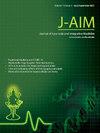阿育吠陀治疗进行性球性麻痹1例报告-罕见的肌萎缩性侧索硬化表型
IF 1.9
Q3 INTEGRATIVE & COMPLEMENTARY MEDICINE
引用次数: 0
摘要
本病例报告是一个毁灭性的疾病,进行性球麻痹(PBP)的67岁男性患者的描述。其主诉为言语不清、听力障碍、四肢全身性无力、握物能力减弱、正常速度行走困难、行走时常感到头晕、严重疲劳、易怒、头重、抑郁、焦虑、记忆力下降、头痛1年。经常规医学检查,脑磁共振成像(MRI)仅检出“部分鞍区空”及年龄相关性轻度脑萎缩,临床诊断为PBP。服用利鲁唑50 mg片剂,每日2次,氟西汀10mg胶囊,夜间1次,疗程3个月,症状未见缓解,就诊于门诊。在阿育吠陀的说法中,PBP类似于Kaphavruta vata。在该患者中,皮塔夫里塔塔症状如bhrama(~头晕)也出现,且严重程度增加。根据黄金海岸诊断标准进行诊断。使用具有减轻kapha和pitta对vata的avarana(~阻断),shodhana(~排出加重的dosha并在内部清洁身体),恢复活力(Rasayana)特性的内部和外部药物,以全面加强神经系统和肌肉骨骼系统,增强平衡和协调,改善语言和记忆。在治疗前后采用“肌萎缩侧索硬化症功能评定量表-修订版(ALSFRS-R)”进行评估。治疗前后分别为35分和45分(总分48分)。治疗有助于提高生活质量,特别是获得症状缓解。由于这是一种预后不良且极有可能导致死亡的毁灭性疾病,建议根据症状的复发情况(如果有的话)定期重复治疗。本文章由计算机程序翻译,如有差异,请以英文原文为准。
A case report on Ayurvedic management of progressive bulbar palsy-A rare amyotrophic lateral sclerosis phenotype
This case report is the description of a devastating illness, Progressive Bulbar Palsy (PBP) of a sixty-seven years old male patient. He presented with complaints of slurred speech, hearing impairment, generalised weakness of limbs, weakened grip to hold objects in hand, difficulty to walk with normal speed, frequent dizzy feeling while walking, severe fatigue, increased anger, heaviness of head, depression, anxiety, decreased memory and headache for 1 year. When he consulted conventional medicine, in Magnetic Resonance Imaging (MRI) of brain, only ‘Partial empty sella’ and age related mild cerebral atrophy was detected and the patient was diagnosed PBP clinically. They prescribed Riluzole 50 mg tablet twice a day and Fluoxetine 10mg capsules at night time for 3 months, but obtained no relief for symptoms and consulted this Out Patient Department (OPD). In Ayurvedic parlance, PBP resembles conditions like Kaphavruta vata. In this patient, Pittavritavata symptoms like bhrama (∼dizziness) was also present in increased severity. Diagnosis was done with the aid of Gold Coast diagnostic criteria. Internal and external medications with properties alleviating avarana (∼occlusion) of vata by kapha and pitta, shodhana (∼expelling the aggravated doshas and cleanses the body internally), rejuvenating (Rasayana) properties, for overall strengthening of nervous system and musculoskeletal system, enhancing balance and coordination, improving speech and memory were used. The assessment was done before and after the treatment by ‘Amyotrophic Lateral Sclerosis Functional Rating Scale-Revised (ALSFRS-R). The score before and after the treatment was 35 and 45 respectively out of 48. The treatment helped to increase the quality of life exceptionally as symptomatic relief was obtained. As it is a devastating disorder with poor prognosis and most probably will lead to death, it is advisable to repeat the treatments in regular intervals, depending on the recurrence of symptoms, if any.
求助全文
通过发布文献求助,成功后即可免费获取论文全文。
去求助
来源期刊

Journal of Ayurveda and Integrative Medicine
INTEGRATIVE & COMPLEMENTARY MEDICINE-
CiteScore
4.70
自引率
12.50%
发文量
136
审稿时长
30 weeks
 求助内容:
求助内容: 应助结果提醒方式:
应助结果提醒方式:


